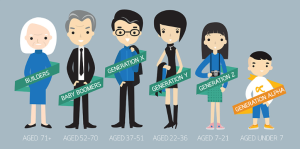The generation gap in homeownership is a topic of interest to many people. Many factors can contribute to the difference in homeownership rates between younger and older millennials. For example, the age group of younger millennials is between 23-31 years old for a generation born between 1990-1998. On the other hand, older millennials are the age group between 32-31, born between 1980-1989.
The generational homeownership gap study affects property markets worldwide, as the decision-making process to purchase homes and real estate are similar.
Generational Difference in Homeownership
Younger Millennials are more likely to be renters than homebuyers. This is because they are less likely to have the financial stability and income needed to purchase a home. Older Millennials, on the other hand, tend to be homeowners who have more financial stability and higher revenues.
A study by the National Association of Realtors found that in 2022, only 36% of people aged 18-34 were homeowners. This is compared with 65% of people aged 35-44 and 76% of people aged 45-54 who were homeowners.
While there is a significant difference between younger Gen Y and older Gen Y in terms of homeownership rates, it’s important to note that both groups can still buy the property or purchase a house for sale if they want it enough.
The most obvious factor is the economy. Younger Millennials entered the workforce during a time when there was a significant economic recession, so they may have had more difficulty saving for a down payment. Conversely, older Millennials entered the workforce when there was an economic boom, so they may have had less trouble keeping a down payment.
The study represents data collected by age groups into three categories.
- Gen Z buyer: age (18 – 22, year born 1999-2011)
- Younger Millennials: generation (23-31, born 1990-1998)
- Older Millennials: generation (32-41, born 1980-1989)

We will dive right into representing the difference between younger and older millennials, as this is where the main parameters and metrics are discussed. Comparing these two main generational groups is where the main buyers are in real estate for all types of markets. Whether low residential, medium, or luxury real estate market.
Factors of Homeownership
They are various factors involved in the decision-making process to become a homeowner. You can never forget the most critical transaction in real estate is always: “location.” The location of your new home is essential. Homebuyers factor in the quality of the neighborhood, commuting times to workplaces, or to meet friends and families. The amenities around the community are a common factor in the decision-making process. Lastly comes the financial aspects in the decision-making process for homeowners across all generations.
We will use four factors of the buyer’s decision-making process while purchasing a home: location, neighborhood, property types, and finances.
Location: Primary Factor in Homeownership

In the past, it was common for people to buy homes in suburbs or rural areas and then commute to work. Nowadays, people are choosing to purchase homes near their work instead. Younger millennials want to stay close to where they work because they want to avoid long commutes and spend more time with their friends. Older millennials often choose city centers as well because they are more likely than younger millennials to have a higher-paying job that is closer in proximity to their workplaces.
The decision of where you live can affect your financial situation and your social life. Younger generations like younger Gen Y are more likely than older generations like Gen X or silent-boomers, for example, to live in city centers near their jobs for convenience, amounting to 50% of younger millennials living near workplaces with an easy commute to work.
Similarly, younger millennials do not factor in easy access to public transportation and convenient commuting to the airport, amounting to less than 5% of becoming a homeowner.
How’s My New Neighborhood

Younger millennials want to be able to walk or take public transit to work and be near shops, restaurants, cafes, and bars. In addition, they want a diverse community with plenty of outdoor space for recreation. On the other hand, older millennials factor in established institutions such as schools, hospitals, recreational facilities, and parks in the decision-making process by 58% before taking the role of homeownership.
Older Millennials
Older Millennials want an easy commute to work with reliable public transportation service and good schools nearby so they can send their children there for a good education. They also like being near parks that offer leisure activities such as tennis or basketball courts or playgrounds for children’s playtime. Older Millennials will factor in more on the quality and design of neighborhoods by 40% compared to younger millennials by around 20%.
Financially Barriers to Homeownership across two Generations
Buying a home is one of the most important financial decisions a person can make. It can have a significant impact on their finances and their future.
The younger millennials are not as financially stable as their older millennial counterparts, and this is because they are building their careers and getting married—younger millennials who are homeowners and single, amount to 80% of total buyers. The factors of home loan mortgage, credit card debts, and student loans play a significant factor amounting to 45% in buying a home. To ease debts from the banks, 29 & younger millennials receive finances from relatives as a gift or a loan from a friend with lower interest rates.

However, the older millennials could complete these steps at an earlier stage, allowing them to accumulate more wealth and invest in real estate. Older millennials went through a time of economic boom; they have accumulated wealth and can afford to pay off the down payment of their homes. Around 35% of older millennials were quoted as saying it’s better to pay the 20%-25% down payment upfront to ease financial burdens in the future.
How Generational Trend Of Homeownership Factors in Southeast Asia
As mentioned above, the decision-making process in homeownership works across all markets worldwide. From America to Southeast Asia, decision-making processes are very similar when diving into different generational trends.
For instance, according to experts in the real estate industry and researchers such as DDproperty, Southeast Asia found a study on home ownership trends in 2022. Property, a major real estate company, is one of the largest in Southeast Asia, with headquarters in Singapore, Malaysia, Thailand, and more.

Property study on Thailand Property Market Outlook in 2022 represents the supply trends of real estate representing buyers choosing new locations on the outskirts of the city center. Significantly the report in Thailand presents younger millennials to pick housing under $250,000. First-time buyers amount to 24.25% to become homeownership. The outskirts of the city center is a significant location because of the design and lifestyle of the neighborhoods. In addition, countries in Southeast Asia are developing new public transportation for residents to easily commute to workplaces instead of taking the morning traffic.
Furthermore, the newer districts have a better year-on-year price growth as the revamp of location design. For example, in Bangkok, the section Khlong San’s year-on-year growth is 169%, which is impressive growth to factor in the decision-making process to become a homeowner. In real estate, location is essential, and combining it with the elements of your property value increasing year-on-year is a good, sound investment.
Homeownership Trends in Southeast Asia
In addition to the property, FazWaz Thailand Real Estate, a leading proptech brokerage firm in Southeast Asia, represents real estate with a data-driven approach for buyers, sellers, and property agents. FazWaz Real Estate data present older millennials as the Southeast’s largest buyers, amounting to 34% of homeownership. In addition, older millennials have the financial power during this year of 2022, dubbed “the road to recovery.”
On the other hand, interest is built by younger millennials seeking to become homeowners between 2022 and 2023. According to the data, younger millennials are interested in apartment or condo types because of two factors. The first factor is the affordability of the homes, and the second is the neighborhood of the new homes.
However, the same factor of slower decision-making is financial. As debts are increasing and interest rates hike increase by all central banks around the globe.
Thailand Real Estate Generational Trends 2022

Bangkok apartments generate the most traffic and are led by older millennials because older supplies are still in storage as the country is recovering from the pandemic. Secondly, because developers have halted new projects to be completed in later years, prices are still lower than market prices with an interest rate, similar to during the peaks of the pandemic.
Every generation age group has similar trends and factors in the decision-making process in the buyer’s journey to becoming a homeowner. Each continent’s customer behavior factors decision-making into four categories: location, neighborhood, property type, and price. In the real estate market, it is about understanding the buyer’s journey with understanding the current market condition and trends of the economy to fully grasp what your buyers’ needs and wants are in order to become a homeowner in any country.





